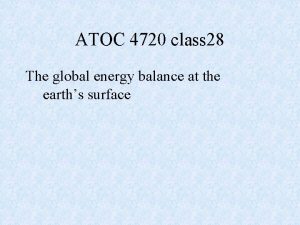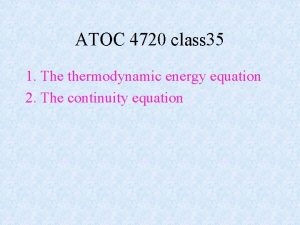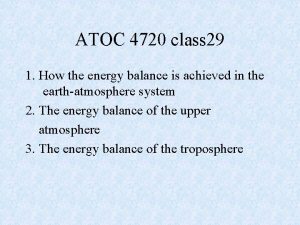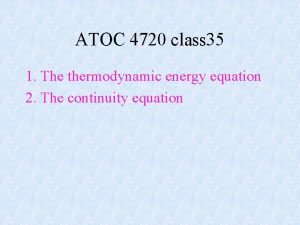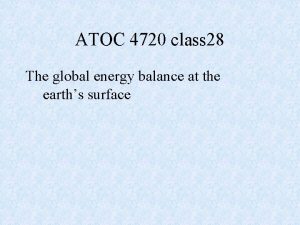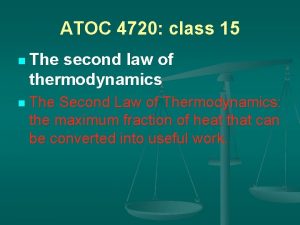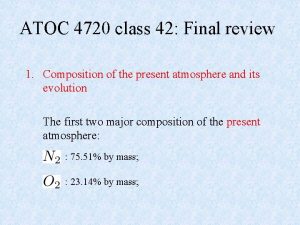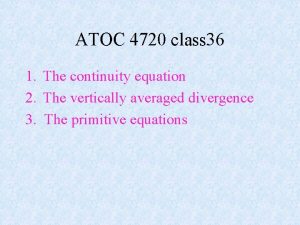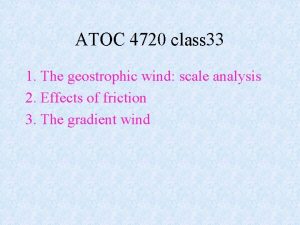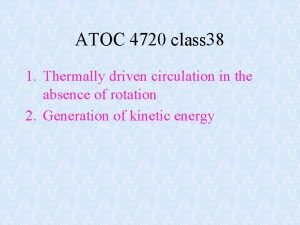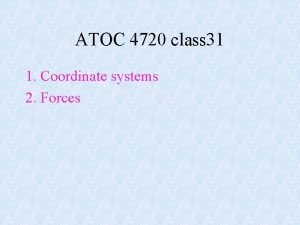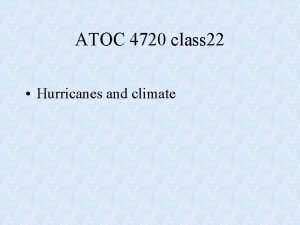ATOC 4720 class 29 1 How the energy













- Slides: 13

ATOC 4720 class 29 1. How the energy balance is achieved in the earth-atmosphere system 2. The energy balance of the upper atmosphere 3. The energy balance of the troposphere

IR rad latent 21% 23% 7% sen

The mean planetary irradiance back into space • Assume the net energy flux through the earth’s surface is negligible, and energy stored in the atmosphere is not systematically changing, • Then at the top of the atmosphere, incoming energy should be balanced by outgoing energy:

S=1380 W/m 2 Incoming solar radiation Outgoing planetary radiation The earth’s radius A---planetary albedo

How the balance is achieved

The energy balance at the earth’s surface 21% 23% 7%

Balance at the top of the atmosphere 100 units incident: Out: 30% reflected 6% longwave radiation from earth 64% emission by atmosphere (38% by water and carbon dioxide molecules; 26% by clouds)

Balance in the atmosphere In: 19% absorbed solar radiation; 15% absorbed the earth’s IR radiation; 30% latent & sensible heat fluxes; Out: 64% IR emission (38% & 26% )

2. The energy balance of the upper atmosphere Above the tropopause: absorption of solar radiation is important. Photoionization and photodissociation of various Gaseous constituents of the upper atmosphere by UV and X-ray.

• Photoionization of thermosphere (most above 90 km, N 2, O gives rise to E- and F-layer): UV & X-ray. Due to this absorption, T in thermosphere (Z>80 km) increases with height to maintain thermal equilibrium; random molecular motion can conduct heat downward. (radiation is ineffective because of the thin air density). T is strongly influenced by solar activity. • Photodissociation of oxygen:

O--major consituent above 100 km, although it is highly Reactive. [mean free path is long at high level] At lower levels: (20 -60 km, say), although O is trace constituent, it is important in forming ozone layer. [Mean Free path is lower at lower level] M: 3 rd molecule to carry excess energy away from the reaction (3 body collision).

The Ozone layer UV: Not much absorbed by photodissociation, so O Quickly recombines with O 2, maintaining ozone layer.

3. The energy balance of the troposphere Troposphere: structure and dynamics are profoundly Influenced by the earth’s surface; Latent and sensible Heat fluxes account for 30% of the total 51% absorbed. Almost all solar radiation with Is absorbed above tropopause; Very little absorption in visible band (maximum solar Emission) Absorption of solar IR radiation mostly occurs in troposphere, Where water vapor is located.
 Energy energy transfer and general energy analysis
Energy energy transfer and general energy analysis Energy energy transfer and general energy analysis
Energy energy transfer and general energy analysis Hát kết hợp bộ gõ cơ thể
Hát kết hợp bộ gõ cơ thể Slidetodoc
Slidetodoc Bổ thể
Bổ thể Tỉ lệ cơ thể trẻ em
Tỉ lệ cơ thể trẻ em Gấu đi như thế nào
Gấu đi như thế nào Glasgow thang điểm
Glasgow thang điểm Bài hát chúa yêu trần thế alleluia
Bài hát chúa yêu trần thế alleluia Các môn thể thao bắt đầu bằng tiếng bóng
Các môn thể thao bắt đầu bằng tiếng bóng Thế nào là hệ số cao nhất
Thế nào là hệ số cao nhất Các châu lục và đại dương trên thế giới
Các châu lục và đại dương trên thế giới Công thức tính độ biến thiên đông lượng
Công thức tính độ biến thiên đông lượng Trời xanh đây là của chúng ta thể thơ
Trời xanh đây là của chúng ta thể thơ














